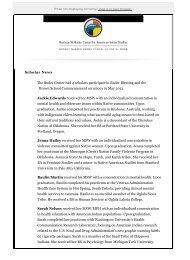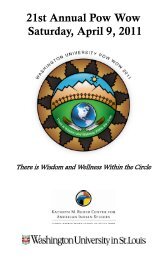Land Tenure and Livelihoods of the Oglala Lakota - Kathryn M ...
Land Tenure and Livelihoods of the Oglala Lakota - Kathryn M ...
Land Tenure and Livelihoods of the Oglala Lakota - Kathryn M ...
You also want an ePaper? Increase the reach of your titles
YUMPU automatically turns print PDFs into web optimized ePapers that Google loves.
Stromberg 9<br />
an external pressure <strong>of</strong> <strong>the</strong> U.S. government, though allotment <strong>and</strong> o<strong>the</strong>r mechanisms, ra<strong>the</strong>r than<br />
historical precedent. The Potato Creek woman continued, "Indian people were never into<br />
agriculture, <strong>the</strong>y were forced into it. It‟s not something <strong>the</strong>y wanted to do, it‟s what <strong>the</strong><br />
government wanted <strong>the</strong>m to do, so <strong>the</strong>re's a lot <strong>of</strong> resistance.” This sentiment was repeated by a<br />
<strong>Oglala</strong> resident: “first <strong>of</strong> all, we're not farmers. Us <strong>Lakota</strong>s aren't good ranchers. We try, maybe a<br />
couple <strong>of</strong> cows, a couple <strong>of</strong> horses, but gradually we end up cooking <strong>the</strong>m up for a feast. But <strong>the</strong><br />
l<strong>and</strong> has been given to us through <strong>the</strong> allotment act.”<br />
The physical environment, <strong>and</strong> society‟s treatment <strong>of</strong> it, is also seen through a different<br />
lens. Though <strong>the</strong> stereotype <strong>of</strong> <strong>the</strong> American Indian as an ecological saint is overblown, natives<br />
do draw upon thoroughly non-Western philosophical roots in crafting an environmental ethic. As<br />
one Kyle woman told me, “with our culture, you got to treat <strong>the</strong> l<strong>and</strong> with respect because it<br />
gives back to you. If you don't take care <strong>of</strong> it, pollute it, whatever, it won't do anything for you.<br />
They outside leasers come in here, overgraze it, after a while it will quit producing.” That <strong>the</strong>se<br />
differences in values contribute to l<strong>and</strong> use patterns is fairly obvious—even ignoring policy<br />
components, tribal members bring a significantly different set <strong>of</strong> assumptions about <strong>the</strong><br />
relationship between humans <strong>and</strong> l<strong>and</strong> when <strong>the</strong>y are contemplating various uses.<br />
‘Mixed-bloods’, ‘Full-bloods’, <strong>and</strong> ‘Nosebleeds’<br />
The enduring cultural dichotomy between „full bloods‟ <strong>and</strong> „mixed-bloods‟ is central to<br />
<strong>the</strong> context <strong>of</strong> l<strong>and</strong> use on <strong>the</strong> reservation. Dated to <strong>the</strong> arrival <strong>of</strong> white settlers in <strong>the</strong> region <strong>and</strong><br />
highlighted with <strong>the</strong> occupation <strong>of</strong> Wounded Knee in 1973, <strong>the</strong>re is a continued awareness <strong>of</strong> <strong>the</strong><br />
distinction between <strong>the</strong>se two groups. Historically, those referred to as „mixed-bloods‟ have held<br />
prominent positions in tribal government <strong>and</strong> operations <strong>and</strong> have been more involved with





